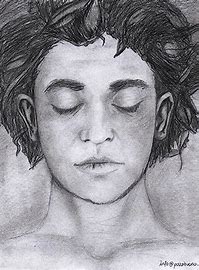Physical Address
304 North Cardinal St.
Dorchester Center, MA 02124
Physical Address
304 North Cardinal St.
Dorchester Center, MA 02124

The Handsomest Drowned Man in the World, in Collected Stories
(Gabriel Garcia Marquez, 1968/1981)
This story begins with a couple of kids playing by the seashore. They see a large object wash up shore, to discover they have found themselves in the company of a dead man. They play with the corpse, as if it was totally normal. They bury him in the sand, then dig him up and continue on until another villager notices what has transpired and alerts the attention of the rest of the village. The man is carried to a nearby home, so he can be examined. He is described to be a larger, tall man. Certainly, taller than any man in the village. He was so tall in fact, that no bed or table could be found to set him on. Women gather to assist in removing the debris from his hair and tattered clothing. With tenderness in mind, the woman removes mud and vegetation that has embedded on his clothing, skin and hair. After freshening the man up, to the best of their capabilities, the woman observes the strength of this brolly man and noticed just how handsome he is. In order to protect his identity, the woman assemble clothing for an old sail, and bridal linen. The oldest women of the village, who looked at him with more compassion than passion, said he looked as if his name would have been Esteban. After Esteban has been cleaned up, the woman admits how strong and handsome he appears. They can’t help but compare him to their own men, now considering them to be the weakest, meanest and most useless men by comparison. The power of imagination comes to life as these women fantasize about the kind of life this man must have lived, even if they don’t know anything about him. The woman wallow in pity as they imagine a life being trapped in such a large body, always ducking under doorways and choosing to stand versus taking the risk of accidentally breaking a chair. The women have created a backstory for this man so vivid, they believe it to be true. They have so much consideration for this man even in death they cover his face with the handkerchief, so the sun won’t disturb his sleep. The men continue to grow more annoyed with these women being so emotionally invested in the body of a dead corpse however it isn’t until the handkerchief is removed, and the men are able to get a good look at this dead man’s face. They are able to sympathize for this man. They are able to humanize him and the circumstances around his death.
“They only had to take the handkerchief off his face to see that he was ashamed, that it was not his fault that he was so big, or so heavy, or so handsome, and if he had known that this was going to happen, he would have looked for a more discreet place to drown in”.
The villagers are able to explore the identity while reimagining it through Esteban. The identity of the people in the village are compared and tested. The community comes together to try to identify, honor and lay this unknown man to rest. The villagers imagine the hardships that a man of the stature must’ve had to endure. They intend on planting flowers and reconstructing the entryway and sizes of their home, ever more changing the identity of the village and honor of the identity of the corpse. I believe the boys playing with the corpse could have been a sign as symbolism as well. The boys encounter of corpse, bury him, then un-bury him, as if bringing him back to life. Similarly, to what the women of the village had also done; brought the man back to life with the power of imagination. Esteban’s identity lives on, and in the imagination of the community.

Comments are closed.
I really enjoyed how you gave not just a summary, but also your presented your own ideas with quotes to support! Great job.
I really enjoy reading your blogs. I love how you summarized the story and provided small details that allows the readers to join with their imagination. Your views and opinions were a great final touch.